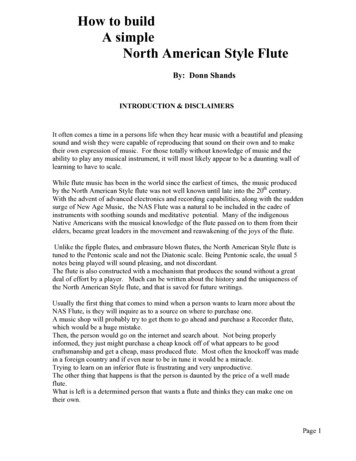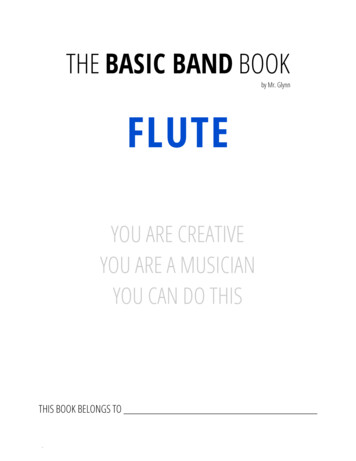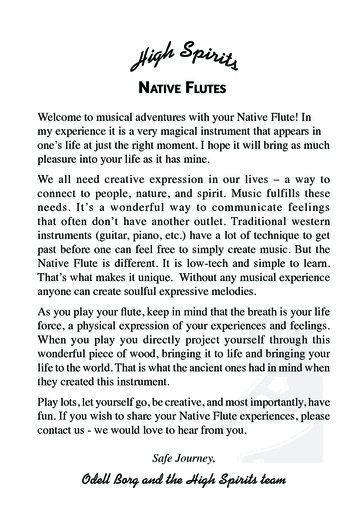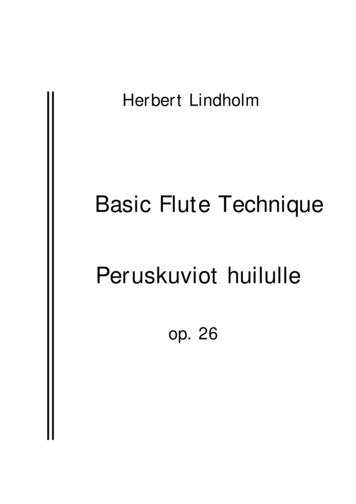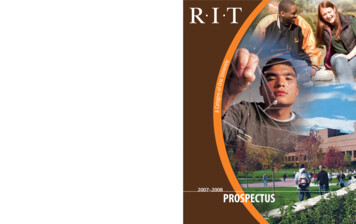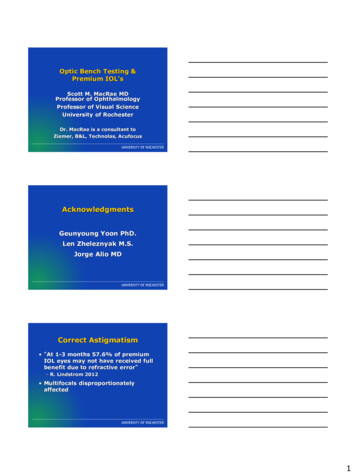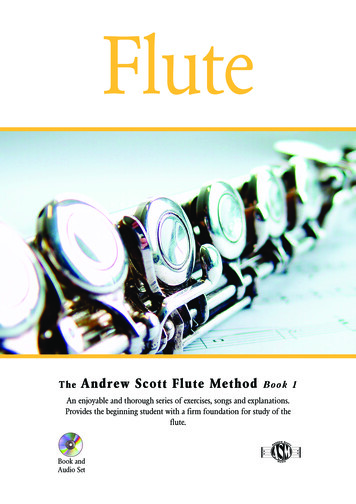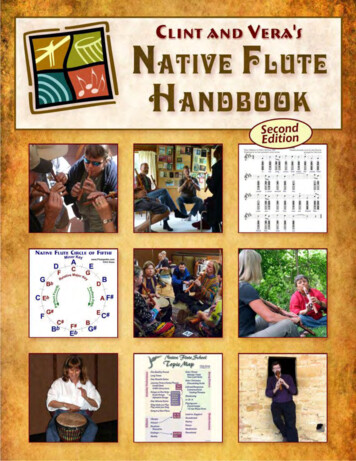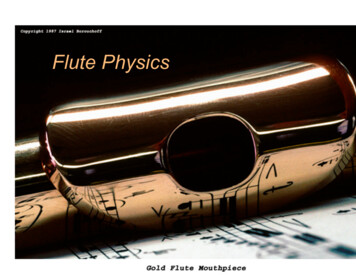
Transcription
Flute Physics1
Normal modes of a columnNo pressurevariation,large motionsNo motions,large pressurevariations2
Is the flute-an open column-a closed column or-one end open and other end closed?How can we find out?3
Experiments on the open pipe Blocking the endHalf blocking the endHow are high notes made easier to play?Harmonics of FluteFrequency f is speed of sound c divided bywavelength λ Fingering and pitch change. Effectivelyshortening the pipe. Comparing the flute and the recorder lengths4
Oscillating AirStream5
PitchWhat changes the pitch?-Speed?-Distance from mouth to edge?-Covering of hole?6
Blowing Breathy sound:How do you get rid of it? High notes vs low notes:What does the flutist do to change octave?(whirly tube?) Vibrato:How does it change the sound?(dynamics, timbre, pitch)How does the flutist do it?7
Thumb holeFavors the higher overtones allowing theflutist to play an octave higher withoutover-blowing. However the thumb hole isnot in the correct place for every note inthe octave. fingering changes fromoctave to octave8
Dynamics As the vibration becomes larger, moreharmonics appear. Loudness in mostinstruments is accompanied by achange in strength of overtones. The flute does not have a big dynamicrange. Why? How do flutists compensate?9
Perceptual fusion and voicing Voices stand out if their overtones movetogether. If overtones don’t move in pitchthen the sound does not sound like a voice.Tones with no variation in pitch sound dull. Demo from Perry Cook’s book. A bell hasmany overtones. 3 groups of overtones aregiven different vibratos. As the vibrato growsthree voices are heard separately.10
Adjusting pitch The distance between the mouth and edge isfixed for a recorder. When you blow harderthe note is sharper. Flutists can compensate by turning the flute. Some recorder players compensate withdifferent fingerings for louder notes! If you add vibrato exact pitch is less precise(add vibrato to allow louder notes to still beeffectively in pitch)– vocalists do this too11
Material of Flute Does it matter? Wood vs metal. Silvervs. steel. How about with recorders? What part of the instrument mostlyaffects the tone?Timbre, temperature and humidity.Experiments with HeadsRecord wooden flutes vs metal flutes12
Wood vs metal fluteswood flute–metal flute –13
The modern flute (Boehm) Larger holes and covering system Key rings and coupling of keys Cylindrical body and tapered headHow do these characteristicsimprove or change the sounds ofthe flute?F# experiment, low high notes flute recorderMoving crown while playing low notes and thenhigh notes14
Recorders and tapered barrelTaper improveshigher octave tuningat the expense ofsome tonality andloudnessExperiment:octaves withpenny whistlesand recorder15
EndcorrectionEffectivelength of pipeis L ΔΔ 0.61a where a is the diameter of the pipeFor a flanged pipe Δ 0.85aAs the end correction depends on wavelength, aflute is not in pitch across octaves. This leads to thedesign of tapered ends.16
End correction Width of the barrel does make a difference.Experiment: diameter barrel End of flute does change the pitch (see Chineseflute). Placement of rice papernear mouth so all noteshave extra vibrationDizi17
Chinese flute Rice paper has its own vibratingfrequencies and also adds noise18
Design of Mouthpiecedepth of mouthpiece determinespitch range for a single note19
20
What sets diameter of bore? Short fat bores are poorer in high overtones. If the bore is too thin, the low overtones aredifficult to excite (e.g. thin whirly tube). This would suggest that one uses the sameratio of bore diameter to length for allinstruments. However for low notes thesound is dull unless the high overtones arestrong. In organs the lower pipes tend to benarrower. (2/3 diameter increase for a pipetwice as long).21
Narrow vs Wide Flutes Narrow flutes are better for high registers Wider flutes louder and have richer timbre e.g. Indian flutes vs penny whistle, piccolo,Japanese flute22
Wide holes vs narrow holes recorder vs bamboo flutes23
Hole size and Flared ends Louder sound if holes are larger The sound that escapes through a hole depends on thewavelength. If the wavelength is much larger than thehole then not much sound radiates. Low instruments tend to have bells at the end Instruments with finger holes (meaning not brass) tend tolack bells. Bells on instruments with holes (clarinets, oboes) tend toprimarily affect notes played with nearly all holes closed. Exceptions: bassoon (bass but no bell), sax (large holesand large bell), trumpet (has bell but is soprano)24
25
Flared ends and buildup ofsound The shape of the end sets boundarycondition as a function of frequency. If radiation is too efficient then soundwon’t build up inside instrument. Tradeoff between build up and radiation.26
Calculating pitchIn practice itis difficult tocalculate thepitchesplayed by aflute as afunction ofpositions andsize of holes27
Trends in pitchTo raise the pitch: Larger holesDecrease distance between holes and blow holeAdditional holes outside the last open holeDecrease distance of cork from blow holeThicker barrel requires larger holes for same pitchThe smaller first open tone hole is, the more effectsubsequent ones have in raising pitch Subsequent holes have less effect on higherregisters28
Calculating effective lengthswith corrections29
Octaves Low octave overtones are present even inthe higher note30
Differences between plastic andwood recorders31
Wooden flutesDifferences: Diameter Holes, size, placement Types of mouthpieces Material/type of woodAdditional compromises Requiring fingers to cover holes No additional mouthpiece Material Restriction to one register32
Pan PipesSolomon Islands – Pan pipes – frommusical instruments of the worldBreathy soundClosed end so an octavelower than a transverseflute33
End blown flutesAlgoza (Rajasthan) end blown, beveledend one drone onemelody flute continuousblowing (circularbreathing like thedigeridu)34
Reed Instrumentswww.tufts.edu/as/wright center/physics 2003 wkshp/book/35
www.tufts.edu/as/wright center/physics 2003 wkshp/book/36
37
38
39
Harmonica Length ofreeds set pitch Two sets ofreeds, one forblow, other fordraw40
Sardinian triple clarinet -Launeddas41
Spectrum of oboe vs flute red is flute, green is oboe42
Excitation for reed instruments For excitation of tube of air trap door analogy for clarinet reedimage from tml#reed converting DC pressure into AC flow43
Timbre depends on how hard you blowimage from tml#reed Blow pressure affects the shape of the airflowcurve and so the timbre. Blowing harder increasesthe strength of higher harmonics.44
Excitation of digi45
Other noisessound recordednear mouthsound recorded inroom46
Note: the shape of the mouthpiece isimportant as it affects the high frequencyresponse of the instrument!47
Wooden trumpetsCentral African Republic Ongo ensemble ofthe Banda peopleconsists of woodenand antelope horntrumpets48
Closed/open pipe Which instruments behave like closed ends?Clarinet, oboe, brass, some pan pipes? Which ones have open/open ends?Organ, flute, recorders, organ pipesWe might expect odd integer overtones from thebrass, however the bell at their end shifts theovertone spectra to nearly all integers49
Wavelength shift dueto conical bore Easiest way to think ofthis is in terms of volumeand air piling up at antinodes. Mouthpiece cuts off theend of the cone but is anapproximate match tovolume of that cone.50
Ocarinas More like Helmholtzresonators. Pitch is changed byadding holes51
Organ pipesTechnologicalinnovations led toimproved air pumpsin the late middleages showcased inchurches52
Types of organpipes open/closed flue type –acoustics similar to flutebut airflow is veryimportant Reed type– tuned byadjusting length of reed –like the quack callerhunters use but with amore interesting resonator.53
Voicing of Craighead-Saunders OrganChrist Church (Episcopal)Eastman Rochester Organ Initiativeby Munetaka Yokata (2008)Adjusting thedepth andshape of the lipThe organ is areproduction of a1776 organ fromVilnius Lithuaniathis image from Oberlin to illustrate voicing54
Organ Pipe VoicingDelay of fundamental harmonic55
The modern flute (Boehm) Larger holes and covering system Key rings and coupling of keys Cylindrical body and tapered head How do these characteristics improve or change the sounds of the flute? F# experiment, low high notes flute recorder
